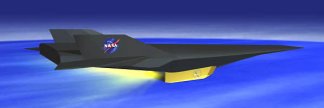Flying the Hyper Skies
A little airplane called the Hyper-X has broken the speed record for jet aircraft.
Share this:
- Share via email (Opens in new window) Email
- Click to share on Facebook (Opens in new window) Facebook
- Click to share on X (Opens in new window) X
- Click to share on Pinterest (Opens in new window) Pinterest
- Click to share on Reddit (Opens in new window) Reddit
- Share to Google Classroom (Opens in new window) Google Classroom
- Click to print (Opens in new window) Print
A little airplane has given new meaning to the term “going hyper.”
The Hyper-X recently broke the record for air-breathing jet planes when it traveled at a hypersonic speed of seven times the speed of sound. That’s about 5,000 miles per hour. At this speed, you’d get around the world—flying along the equator—in less than 5 hours.
 |
|
Powered by its scramjet engines (shown in gold), the black, unmanned X-43A flew at a record speed for an air-breathing jet plane. The experimental plane is only 12 feet long. |
| NASA |
The Hyper-X is an unmanned, experimental aircraft just 12 feet long. It achieves hypersonic speed using a special sort of engine known as a scramjet. It may sound like something from a comic book, but engineers have been experimenting with scramjets since the 1960s.
For an engine to burn fuel and produce energy, it needs oxygen. A jet engine, like those on passenger airplanes, gets oxygen from the air. A rocket engine typically goes faster but has to carry its own supply of oxygen. A scramjet engine goes as fast as a rocket, but it doesn’t have to carry its own oxygen supply.
A scramjet’s special design allows it to extract oxygen from the air that flows through the engine. And it does so without letting the fast-moving air put out the combustion flames. However, a scramjet engine works properly only at speeds greater than five times the speed of sound.
A booster rocket carried the Hyper-X to an altitude of about 100,000 feet for its test flight. The aircraft’s record-beating flight lasted just 11 seconds.
In the future, engineers predict, airplanes equipped with scramjet engines could transport cargo quickly and cheaply to the brink of space. Hypersonic airliners could carry passengers anywhere in the world in just a few hours.
Out of the three experimental Hyper-X aircraft built for NASA, only one is now left. The agency has plans for another, 11-second hypersonic flight, this time at 10 times the speed of sound.
Hang on tight!—S. McDonagh
Going Deeper:
Weiss, Peter. 2004. Soaring at hyperspeed: Long-sought technology finally propels a plane. Science News 165(April 3):213-214. Available at http://www.sciencenews.org/articles/20040403/fob6.asp .
You can learn more about NASA’s Hyper-X plane at oea.larc.nasa.gov/PAIS/FS-2003-07-77-LaRC.html and www.nasa.gov/missions/research/x43-main.html (NASA).






